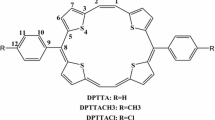Abstract
The effect of dimensionality (1D to 2D) on charge carrier mobility have been studied thoroughly on three In(III)-isophthalate based MOFs [In-IA-1D, In-IA-2D-1 and -2]. In-IA-1D possess 1D nanotubular architecture with [(CH3)2NH2]+. In-IA-2D-1 have 2D layers containing only [(CH3)2NH2]+ cations. Whereas, In-IA-2D-2 have [(CH3)2NH2]+ cations as well as solvent DMF molecule inside the crystal structure. Due to presence of the π–π stacking arrangement among the phenyl rings of IA moieties facilitates the high charge carrier mobility (4.6 × 10−3 cm2 V−1 s−1 at VG = −40 V) in In-IA-2D-2. However, In-IA-1D and In-IA-2D-1 does not show any charge carrier mobility due to absence of π–π stacking arrangement.



Similar content being viewed by others
References
Wei Z, Hong W, Geng H, Wang C, Liu Y, Li R, Xu W, Shuai Z, Hu W, Wang Q, Zhu D (2010) Organic single crystal field-effect transistors based on 6h-pyrrolo[3,2–b:4,5–b] bis [1,4] benzothiazine and its derivatives. Adv Mater 22:2458–2462
Jiang L, Hu W, Wei Z, Xu W, Meng H (2009) High-performance organic single-crystal transistors and digital inverters of an anthracene derivative. Adv Mater 21:3649–3653
Kang SJ, Bae I, Park YJ, Park TH, Sung J, Yoon SC, Kim KH, Choi DH, Park C (2009) Non-volatile ferroelectric poly(vinylidene fluoride-co-trifluoroethylene) memory based on a single-crystalline tri-isopropylsilylethynyl pentacene field-effect transistor. Adv Funct Mater 19:1609–1616
Sirringhaus H (2005) Device physics of solution-processed organic field-effect transistors. Adv Mater 17:2411–2425
Sun Y, Liu Y, Zhu D (2005) Advances in organic field-effect transistors. J Mater Chem 15:53–65
Veres J, Ogier S, Lloyd G, de Leeuw D (2004) Gate insulators in organic field-effect transistors. Chem Mater 16:4543–4555
Katz HE, Bao Z, Gilat SL (2001) Synthetic chemistry for ultrapure, processable, and high-mobility organic transistor semiconductors. Acc Chem Res 34:359–369
Murphy AR, Frechet JMJ (2007) Organic semiconducting oligomers for use in thin film transistors. Chem Rev 107:1066–1096
Wang L, Nan F, Yang X, Peng Q, Li Q, Shuai Z (2010) Computational methods for design of organic materials with high charge mobility. Chem Soc Rev 39:423–434
Eddaoudi M, Moler DB, Li H, Chen B, Reinekee TM, O’Keeffe M, Yaghi OM (2001) Modular chemistry: secondary building units as a basis for the design of highly porous and robust metal-organic carboxylate frameworks. Acc Chem Res 34:319–330
Janiak C (1997) Functional organic analogues of zeolites based on metal–organic coordination framework. Angew Chem Int Ed Engl 36:1431–1434
Blake AJ, Champness NR, Hubberstey P, Li W-S, Withersby MA, Schroder M (1999) Inorganic crystal engineering using self-assembly of tailored building-blocks. Coord Chem Rev 183:117–138
Kesanli B, Cui Y, Smith M, Bittner E, Bockrath B, Lin W (2005) Highly interpenetrated metal–organic frameworks for hydrogen storage. Angew Chem Int Ed 44:72–75
Kitagawa S, Kitaura R, Noro S-I (2004) Functional porous coordination polymers. Angew Chem Int Ed 43:2334–2375
Ferey G (2008) Hybrid porous solids: past, present, future. Chem Soc Rev 37:191–214
Chen B, Xiang S, Qian G (2010) Metal−organic frameworks with functional pores for recognition of small molecules. Acc Chem Res 43:1115–1124
Ma L, Abney C, Lin W (2009) Enantioselective catalysis with homochiral metal–organic frameworks. Chem Soc Rev 38:1248–1256
Gu ZG, Cai YP, Fang HC, Zhou ZY, Thallapally PK, Tian JA, Liu J, Exarhos GJ (2010) Conversion of nonporous helical cadmium organic framework to a porous form. Chem Commun 46:5373–5375
Chen B, Eddaoudi M, Hyde ST, O’Keeffe M, Yaghi OM (2001) Interwoven metal-organic framework on a periodic minimal surface with extra-large pores. Science 291:1021–1023
Panda T, Pachfule P, Chen Y, Jiang J, Banerjee R (2011) Amino functionalized zeolitic tetrazolate framework (ZTF) with high capacity for storage of carbon dioxide. Chem Commun 47:2011–2013
Panda T, Pachfule P, Banerjee R (2011) Template induced structural isomerism and enhancement of porosity in manganese(II) based metal–organic frameworks (Mn-MOFs). Chem Commun 47:7674–7676
Feng X, Ding X, Jiang D (2012) Covalent organic frameworks. Chem Soc Rev 41:6010–6022
Bertrand GHV, Michaelis VK, Ong T-C, Griffin RG, Dinca M (2013) Thiophene-based covalent organic frameworks. Proc Natl Acad Sci USA 110:4923–4928
Narayan TC, Miyakai T, Seki S, Dinca M (2012) High charge mobility in a tetrathiafulvalene-based microporous metal-organic framework. J Am Chem Soc 134:12932–12935
Sun L, Miyakai T, Seki S, Dinca M (2013) Mn2(2,5-disulfhydrylbenzene-1,4-dicarboxylate): a microporous MOF with infinite (-Mn-S-)∞ chains and high intrinsic charge mobility. J Am Chem Soc 135:8185–8188
Panda T, Kundu T, Banerjee R (2013) Structural isomerism leading to variable proton conductivity in indium (III) isophthalic acid based frameworks. Chem Commun 49:6197–6199
Panda T, Kundu T, Banerjee R (2012) Self-assembled one dimensional functionalized metal–organic nanotubes (MONTs) for proton conduction. Chem Commun 48:5464–5466
Noh Y-Y, Kim J-J, Yoshida Y, Yase K (2003) Triangular nanoplates of silver: synthesis, characterization, and use as sacrificial templates for generating triangular nanorings of gold. Adv Mater 15:695–699
Arulkashmir A, Mahale RY, Dharmapurikar SS, Jangid MK, Krishnamoorthy K (2012) Supramolecular interaction facilitated small molecule films for organic field effect transistors. Polym Chem 3:1641–1646
Lu W, Roy VAL, Che CM (2006) Self-assembled nanostructures with tridentate cyclometalated platinum(II) complexes. Chem Commun 38:3972–3974
Acknowledgments
TP acknowledge CSIR for SRF. RB acknowledges CSIR’s Five Year Plan Project (CSC0122 and CSC0102) for funding. Financial assistance from BRNS (2011/37C/44/BRNS) is acknowledged. We also acknowledge Dr K. Krishnamoorthy and Mr Arulraj Arulkashmir for their kind help regarding charge carrier mobility studies.
Author information
Authors and Affiliations
Corresponding author
Rights and permissions
About this article
Cite this article
Panda, T., Banerjee, R. High Charge Carrier Mobility in Two Dimensional Indium (III) Isophthalic Acid Based Frameworks. Proc. Natl. Acad. Sci., India, Sect. A Phys. Sci. 84, 331–336 (2014). https://doi.org/10.1007/s40010-014-0152-6
Received:
Accepted:
Published:
Issue Date:
DOI: https://doi.org/10.1007/s40010-014-0152-6




